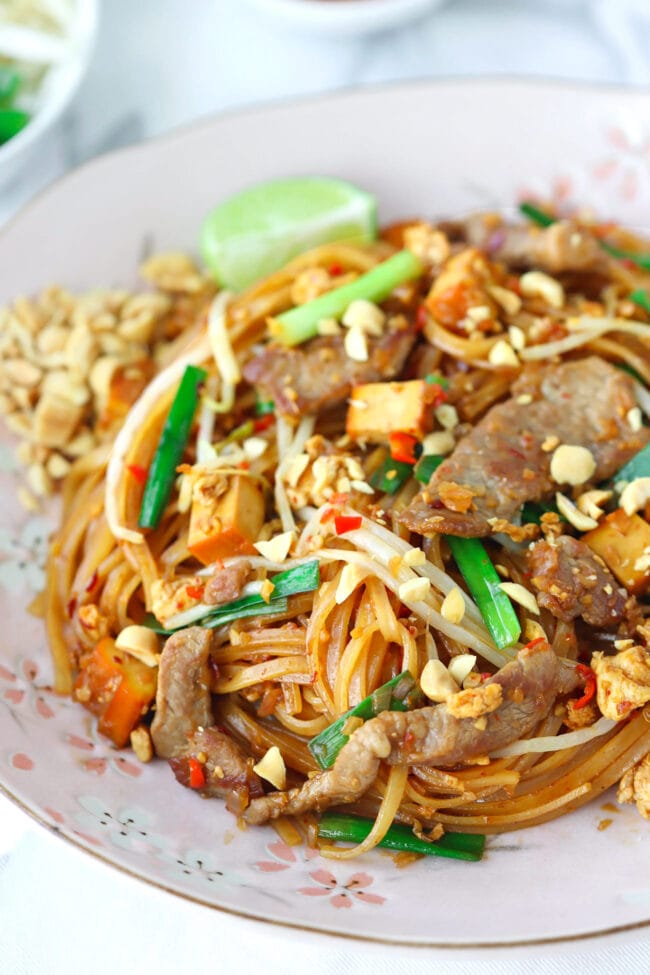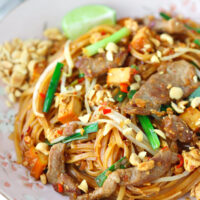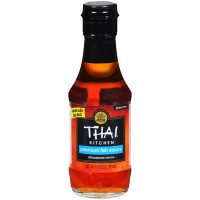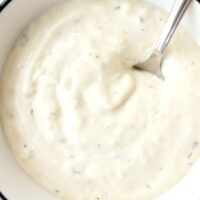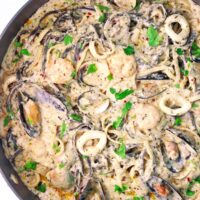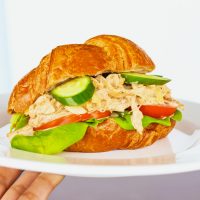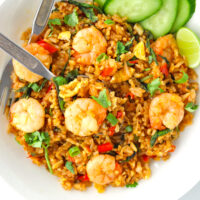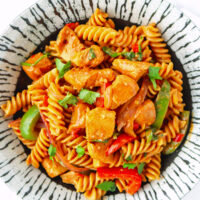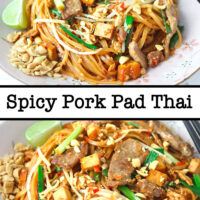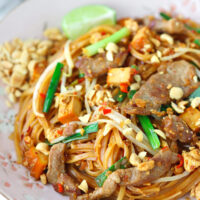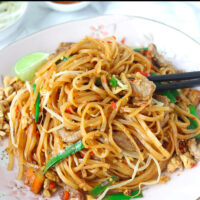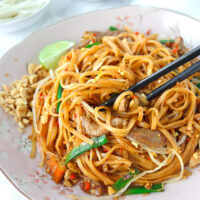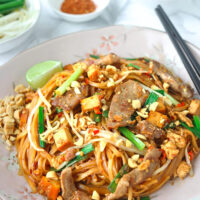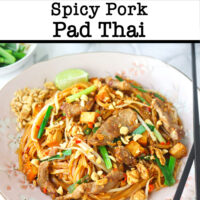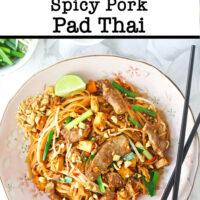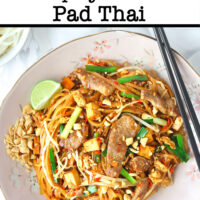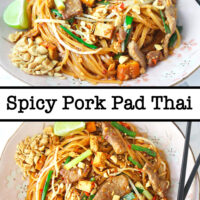Spicy Pork Pad Thai
This post contains affiliate links.
This Spicy Pork Pad Thai is quick and easy to make, and incredibly tasty with spicy, savory, sweet, and sour notes! It’s ready to go in just 35 minutes, can be adapted to be made vegetarian, vegan, and gluten-free, and tastes a million times better than takeout!
Spicy, savory, sweet, sour, tender slices of pork and NOODLES! This Spicy Pork Pad Thai is speaking my love language. 😍
Let’s get something straight. When I get takeout from or dine at a Thai restaurant, I NEVER order Pad Thai. I dislike the restaurant versions here in Hong Kong and anywhere outside of Thailand due to the copious amounts of sugar they add.
I did however, love the Pad Thai from a street food cart that I once had during a trip to Bangkok. This version was inspired by it.
It’s got all the lovely sweet and sour notes that the street food hawker infused into that wonderful Pad Thai. It also has plenty of heat from fresh red chilies and crushed red pepper flakes. (You can of course, leave out both to make this mild if you prefer.) Also, I’ve omitted the dried shrimp that is traditionally used in Thailand simply because of preference. I’ve also opted to make this Pad Thai with pork instead of fresh shrimp.
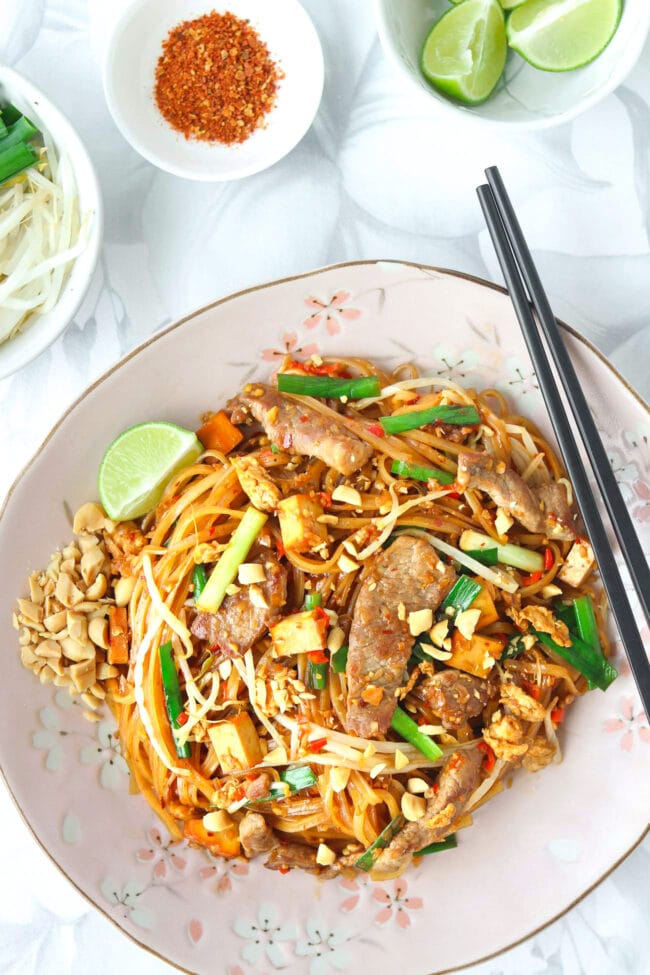
Why This Recipe Works
- Marinating and searing the thin slices of pork first before tossing it with the noodles, sauce, and veggies makes the meat more flavorful and delicious thanks to the maillard (browning) reaction.
- It’s quick and easy to make. All you need is 35 minutes, so this recipe is perfect for busy weeknights.
- Tamarind paste, which is more readily available in most countries than the tamarind fruit, adds the perfect tangy notes that is intrinsic to Pad Thai.
- It’s customizable with your choice of protein. Chicken, shrimp, beef, or tofu would all work well if pork is not your thing.
- You can make it vegetarian, vegan, and gluten-free if needed.
- It’s spicy, and boasts highly addictive salty, sweet and sour flavors!
Ready to slurp on this deliciousness? Gather all the ingredients, grab your wok, and let’s make some tasty Pad Thai! 💃
Ingredients
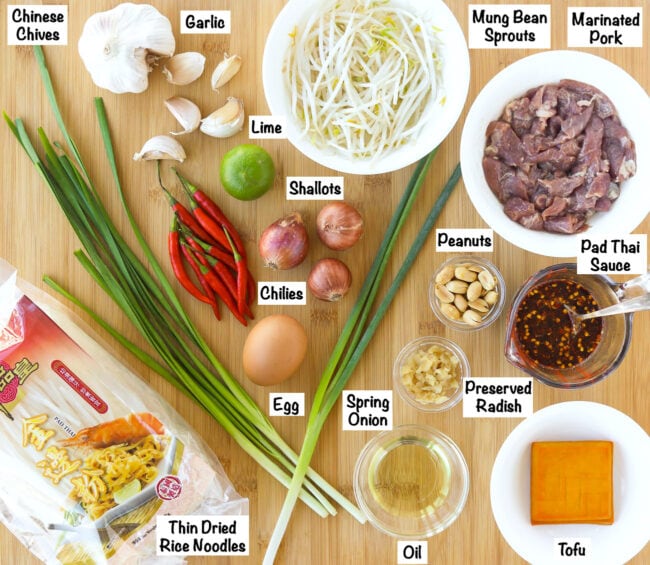
Ingredient Notes
Here are some quick notes on the ingredients. (Full ingredient list and amounts can be found in the recipe card below.)
- Marinated Pork: I used a pork scotch fillet, which is also known as pork neck, pork shoulder, or collar butt steaks. Pork loin or tenderloin would work well too. We’ll be marinating this in light soy sauce, corn starch, and a bit of canola oil to keep things moist.
- Pad Thai Sauce: A quick blend of fish sauce, light soy sauce, sweet dark soy sauce, tamarind paste, freshly squeezed lime juice, coconut sugar, and crushed red pepper chili flakes.
- Tamarind Paste: Look for this at your local Asian grocery store. Or you can purchase it online. Note that this is the Thai type tamarind paste, not the Indian type, which is black and sticky. They are different from each other. Also, different brands will have varying levels of tanginess. If the one you pick up is very sour, use less than the amount I’ve indicated. You can also add more coconut sugar to the sauce if needed to balance out the tartness. I use Talad Thai Tamarind Paste, which is made up of 70% tamarind and 30% water. Depending on where you live, it may be called tamarind concentrate or puree. It is usually sold in small glass jars or containers.
- Coconut Sugar: Substitute with light brown sugar if coconut sugar is unavailable.
- Thin Dried Flat Rice Noodles: Known as sen lek in Thai. Ideally, the noodles should be 2-3mm wide.
- Asian Red Shallots: If unavailable, you can substitute with ¼ of a medium red onion.
- Red Chilies: Bird’s Eye is preferred, but Holland or other small red chilies will work too. Feel free to use as many or as few as you prefer depending on your heat level preference. Omit entirely if you’d like to make this Pad Thai mild.
- Preserved/Pickled Radish: Traditionally, Thai preserved/pickled radish is used in Pad Thai in Thailand. But if this is hard to track down for you, you can omit it.
- Pressed Firm Yellow Tofu: If you can’t find pressed tofu easily, you can make some crispy-pan-fried tofu cubes using either firm or extra firm tofu to add to the Pad Thai.
- Chinese Chives: These are also known as garlic chives. You can try finding them in your local Asian supermarket if you’re based outside of Asia. If you’re based in Asia, they should be available in wet markets and most supermarkets. Substitute with spring onion (scallion) if unavailable.
- Peanuts: I like using unsalted oil roasted peanuts. But lightly salted is fine if that’s what you prefer or have on hand.
- To Serve (optional): More bean sprouts, chopped spring onion, chopped Chinese chives, chopped oil roasted peanuts, lime wedges for squeezing, and crushed red pepper chili flakes.
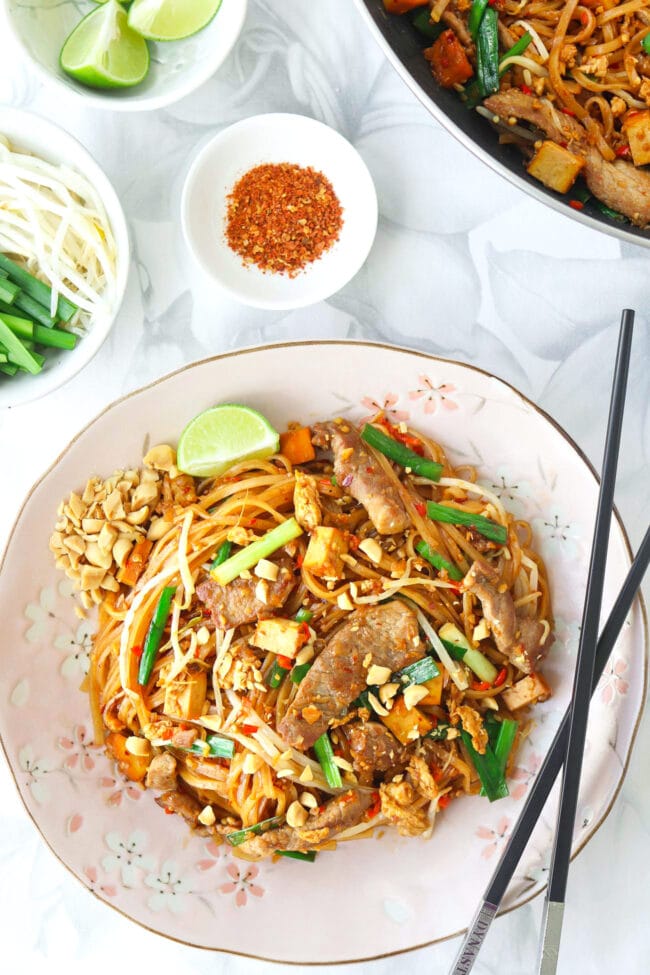
How to Make Spicy Pork Pad Thai
Prep:
- Marinate the pork: Clean and trim off excess fat from the pork, then thinly slice and add to medium sized bowl. Add the corn starch, light soy sauce, and 1 TSP canola oil to the bowl, then mix with a spoon until the pork is evenly coated in the marinade. Set aside to marinate for 20 minutes while you prepare the other ingredients.
- Prepare the rest of the ingredients: Soak the rice noodles in a bowl filled with room temperature water for 20-30 minutes, or until they have softened and are pliable. Drain and set aside. Chop/prepare the shallots, garlic, red chilies, Chinese chives, spring onion, and yellow tofu. Rinse and drain the mung bean sprouts and set aside.
- Make the Pad Thai Sauce: Combine the fish sauce, light soy sauce, sweet dark soy sauce, tamarind paste, lime juice, coconut sugar, and crushed red pepper chili flakes in a measuring cup (for easier pouring) or small bowl. Mix with a spoon until thoroughly combined, then set aside.
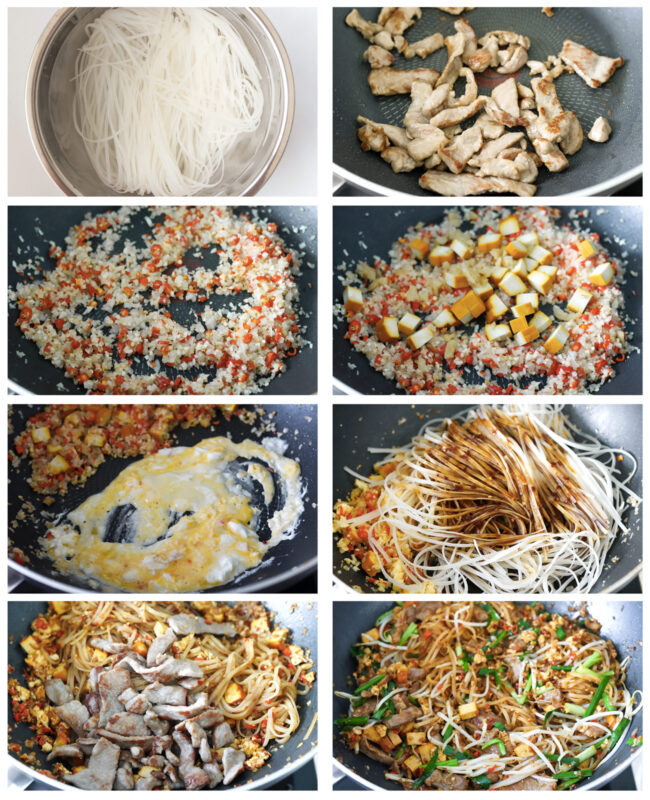
For the Spicy Pork Pad Thai:
- Cook the pork: Heat 1 tablespoon of canola oil (or vegetable oil if using) over high heat in a large wok or large deep sauté pan. Once hot, add the pork and spread out the pieces in an even layer in the wok. Cook for 1 minute, undisturbed, then turn over the pieces to sear the other side for another minute. Stir-fry for 30 seconds or until the pork has almost fully cooked through. Use a slotted spoon to transfer to a clean bowl and set aside.
- Sauté aromatics: Heat 1.5 tablespoons canola oil in the wok over high heat. Once hot, add the shallots, garlic, and red chilies. Stir-fry for a minute until fragrant.
- Add pickled radish and tofu: Add the pickled radish and tofu and toss to combine.
- Scramble the egg: Push everything to the side of the wok and add the remaining half tablespoon of oil. Add the egg and scramble. Then stir-fry to combine with everything else.
- Add noodles and sauce: Add the rice noodles, 1 tablespoon of water, and pour the Pad Thai Sauce on top of the noodles. Toss through to combine with the aromatics. (Note: It may look a bit too liquidy at first, but the noodles will quickly start to cook in the liquid and absorb the sauce.)
- Add the pork and veggies: Add the pork and toss to combine. Then add the mung bean sprouts, Chinese chives, and spring onion. Stir-fry for 40 seconds to 1 minute, then switch off the heat. (Note: The residual heat from pan will help wilt and soften the veggies once taken off the heat.)
- To Serve: Divide the Spicy Pork Pad Thai evenly into plates and garnish with chopped peanuts. Serve with more bean sprouts, spring onion, Chinese chives, chopped peanuts, lime wedges for squeezing, and crushed red pepper chili flakes if desired.
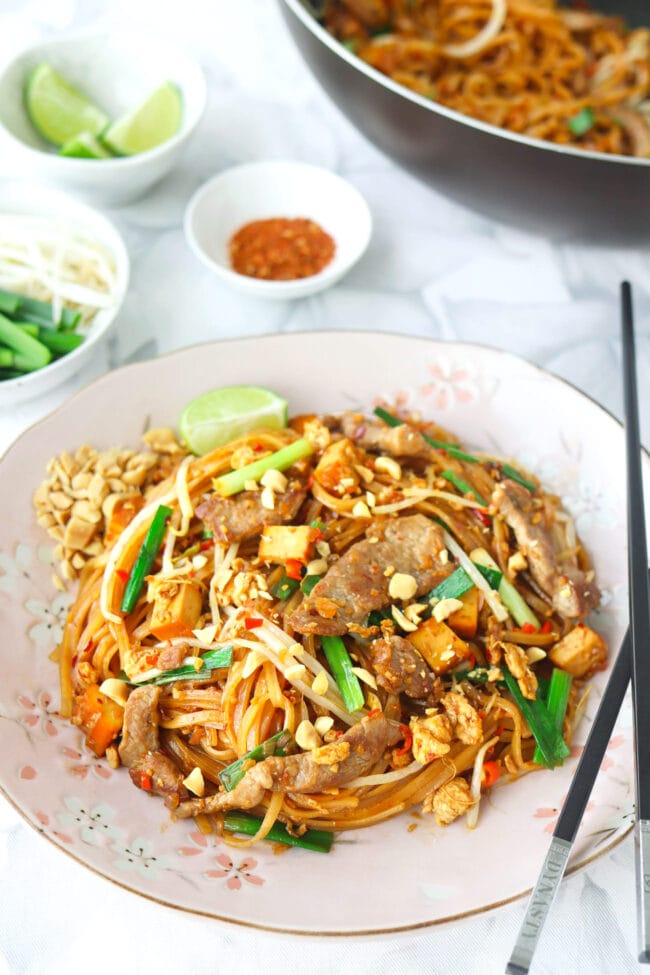
Full ingredient amounts and instructions are in the recipe card below.
Cook’s Tips
- Check the preparation instructions on your pack of rice noodles. Mine only required soaking in room temperature water until the noodles softened. But some other brands may require you to soak in warm water, or even briefly boil them. Prepare them as indicated in the package instructions before using them for this Spicy Pork Pad Thai.
- Use high heat. Crank up the heat on your stove for the stir-fry to prevent the noodles from clumping together.
- Use a large wok or pan. You don’t want to overcrowd the wok or pan as it will make it difficult to toss and stir-fry the ingredients. The noodles may also be more prone to clumping and breaking if your wok is not large enough.
- Have everything prepared before you start cooking. Stir-fries in general go by very quickly. This is especially true in the case of this Pad Thai. Make sure you’ve prepared all the ingredients before you switch on the flame so that you’re not struggling to prepare anything while stir-frying.
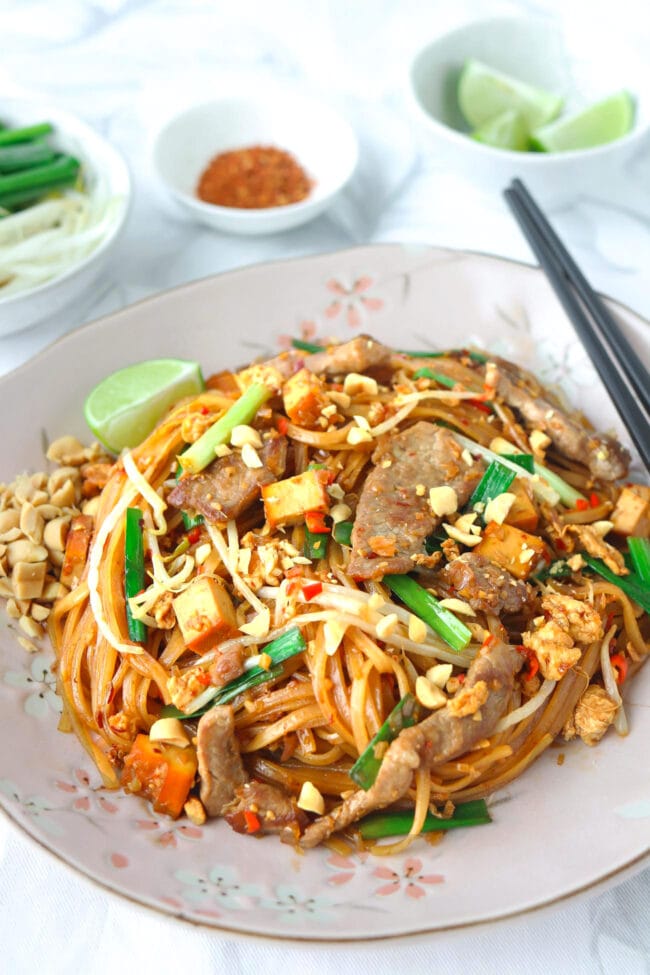
FAQs
Can I use another protein instead of pork?
Absolutely! Chicken, shrimp, thinly sliced beef, or tofu would all taste great.
- Chicken: Use 200-300 grams of chicken thighs or breasts. Thinly slice or cut into bite-sized pieces. Use the same marinade as you would for the pork (1 teaspoon cornstarch, 1 teaspoon light soy sauce, and 1 teaspoon canola oil). Heat 1 tablespoon of canola oil in a large wok. Once hot, add the chicken and spread out the pieces in an even layer in the wok. Cook for 1 minute, undisturbed, then turn over the pieces to sear the other side for another minute. Stir-fry for 30-60 seconds or until the chicken has almost fully cooked through. Use a slotted spoon to transfer to a clean bowl.
- Shrimp: Use 200 grams. Peel and devein the shrimp if they aren’t already. Season with ½ teaspoon of kosher salt (or more to taste. Heat 1 tablespoon of canola oil in a large wok. Once hot, add the shrimp and sauté for 1-2 minutes, or until no longer pink. Use a slotted spoon to transfer to a clean bowl.
- Beef: Use 200 grams of thinly sliced skirt steak or other lean beef cut. Use the same method to cook the beef as you would for the chicken or pork.
- Tofu: Use 5-6 squares (250-300 grams) pressed firm yellow tofu in place of the pork. Alternatively, you can make some crispy-pan-fried tofu cubes to use in the Pad Thai if you can’t find pressed firm yellow tofu. Pan-frying the tofu first will prevent the tofu from breaking down in the stir-fry.
Can I use other types of tofu if I can’t find pressed firm yellow tofu?
Yes. You can make crispy pan-fried tofu cubes using firm or extra firm tofu. Pan-frying the tofu first will firm it up and prevent it from crumbling during stir-frying.
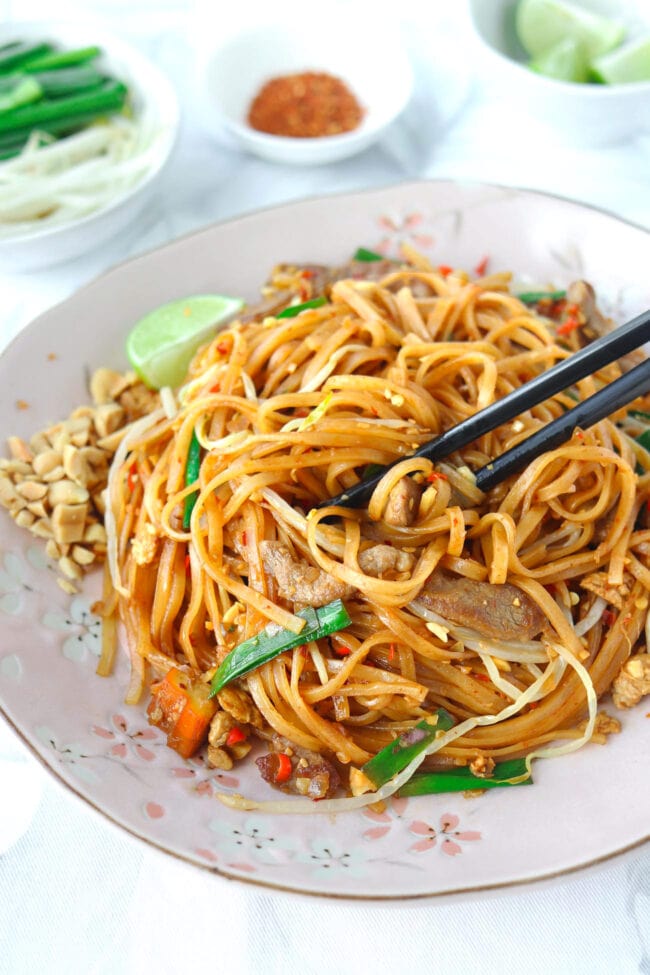
Can I make this gluten-free?
Use a gluten-free soy sauce and gluten-free sweet dark soy sauce such as this gluten-free kecap manis. Also, double check to make sure that your fish sauce is GF certified.
Can I make this vegetarian?
Sure. Use a vegan fish sauce and omit the pork (and the marinade ingredients for it). Use 5-6 squares (250-300 grams) pressed firm yellow tofu in place of the pork. Alternatively, you can make crispy-pan-fried tofu cubes for the Pad Thai if you can’t find pressed firm yellow tofu.
Can I make this vegan?
Same as for making it vegetarian (see above), but omit the egg as well.
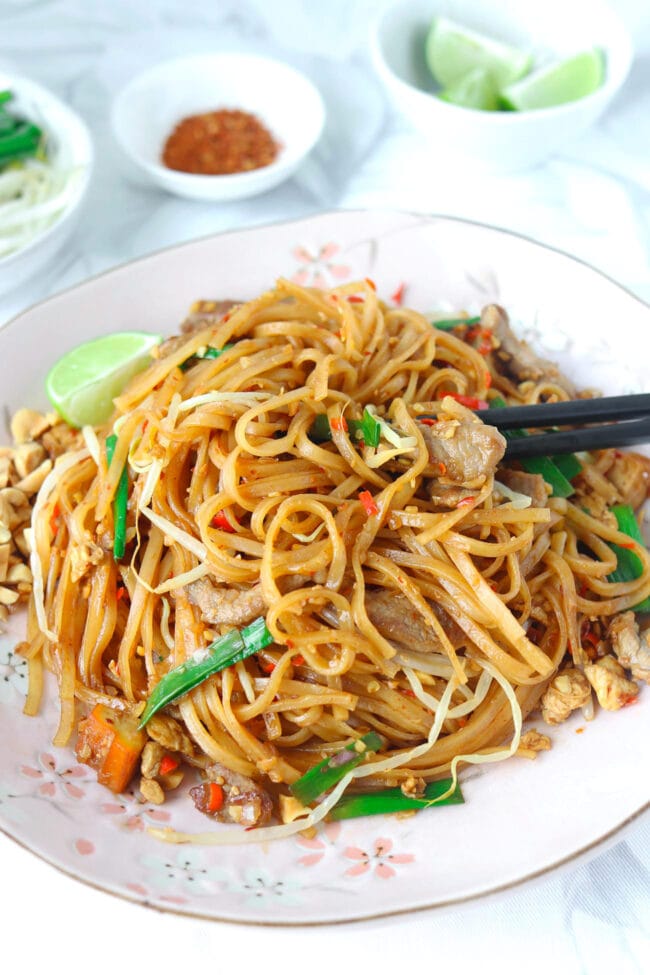
Can I make this mild?
Omit the crushed red pepper chili flakes for the sauce and the Bird’s eye red chilies for the Pad Thai.
Can I make this spicier?
Yes, you can! Add more crushed red pepper chili flakes to the sauce, and additional Bird’s eye red chilies to the Pad Thai.
For chili heads, I highly recommend serving this Spicy Pork Pad Thai with a bit of ground Ghorpian pepper or even using it to make the sauce. It’s a cross between a Trinidad Scorpion and Ghost pepper. A little sprinkle on top takes this Pad Thai to a whole other level of delicious spiciness!
I received some from Pandemic Polly Peppers – a small business run by a husband and wife team in Colorado – recently and absolutely love the spice and berry undertones in this particular ground pepper. They grow all sorts of hot peppers on their small family farm in Colorado. Check them out if you love your spice and like trying different type of ground spicy peppers.
Disclosure: I received a sample of the ground Ghorpian pepper from Pandemic Polly Peppers. All opinions expressed in this post are my own.
Can I make this ahead?
Unfortunately, I don’t recommend making this ahead because the noodles will absorb all the sauce and it’ll taste dry if not eaten immediately, or at the very least, on the day of cooking.
However, you can prepare the fresh ingredients and make the sauce a day in advance if you like. Store the prepared/chopped fresh ingredients in sealed airtight containers in the refrigerator. Make the sauce in a small jar with a lid and store in the refrigerator until you’re ready to cook the Pad Thai.
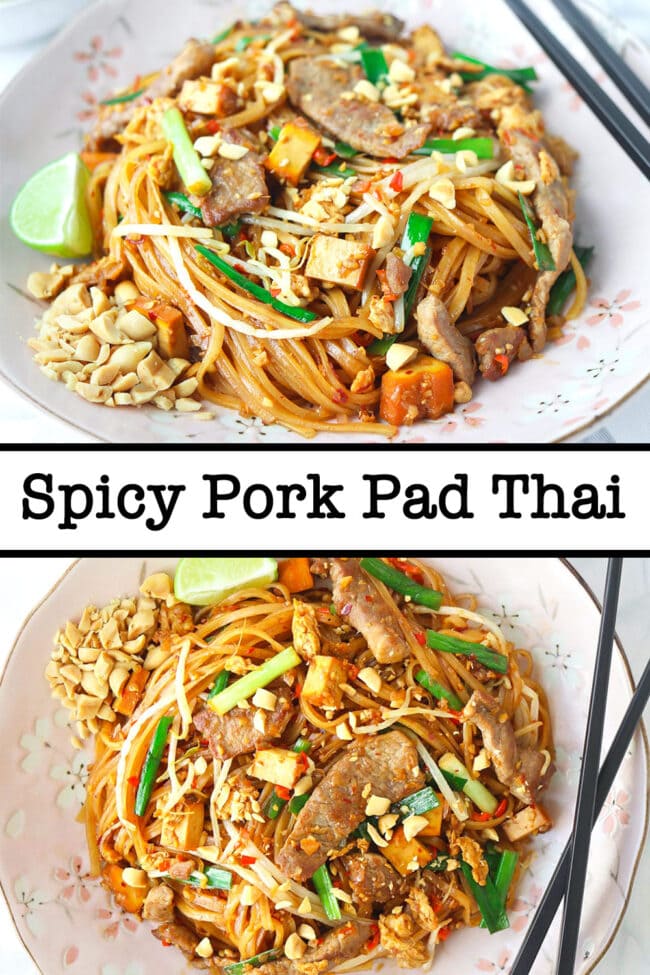
More Thai Favorites
- Easy Thai Green Chicken Curry
- Peanut Butter Chicken Curry
- Thai Holy Basil Chicken (Pad Kra Pow Gai)
- Thai Basil Chicken Spaghetti
- Peanut Sauce Ground Pork Stir-fry
- Or feel free to browse the entire Thai recipes collection.
MADE THIS RECIPE? If you make this recipe, leave a comment below and let me know how you liked it! Take a photo and tag it with @thatspicychick on Instagram and hashtag it #thatspicychick and I’ll be sure to share your masterpiece!
STAY CONNECTED! You can also follow me on Pinterest, Facebook or Instagram. Sign up for my email list to get my latest recipe in your inbox weekly!
PrintSpicy Pork Pad Thai
This Spicy Pork Pad Thai is quick and easy to make, and incredibly tasty with spicy, savory, sweet, and sour notes! It’s ready to go in just 35 minutes, can be adapted to be made vegetarian, vegan, and gluten-free, and tastes a million times better than takeout!
- Prep Time: 20
- Cook Time: 15
- Total Time: 35 minutes
- Yield: 3 1x
- Category: Dinner
- Method: Stir-fry
- Cuisine: Thai
Ingredients
For the Pork Marinade:
- 200 grams Pork Scotch Fillet (also known as pork neck, pork shoulder, or collar butt steaks) – thinly sliced
- 1 TSP Corn Starch
- 1 TSP Light Soy Sauce
- 1 TSP + 1 TBLS Canola or Vegetable oil, divided
For the Pad Thai Sauce:
- 1.5 TBLS Fish Sauce
- 1.5 TBLS Light Soy Sauce
- ½ TBLS Sweet Dark Soy Sauce
- 2 TBLS Tamarind Paste (also known as tamarind concentrate or puree)
- 1 TBLS freshly squeezed Lime Juice
- ½ disc (25 grams) Coconut Sugar – shaved with a knife (substitute with 1 TBLS light brown sugar or more to taste if unavailable)
- 1 TSP Crushed Red Pepper Chili Flakes, to taste
For the Spicy Pork Pad Thai:
- 150 grams / 5.3 ounces Thin Dried Flat Rice Noodles (sen lek, about 2-3mm wide) – soaked in water for 20-30 minutes or until softened
- 2 TBLS Canola or Vegetable Oil
- 3 Asian Red Shallots – finely chopped (substitute with 1/4 of medium red onion if unavailable)
- 5 Garlic cloves – minced
- 4–12 Red Chilies (Bird’s Eye preferred, but Holland or other small red chilies will work too), to taste – chopped
- 1 TBLS Preserved/Pickled Radish (omit if unavailable)
- 1 (50-60 grams) square pressed firm Yellow Tofu – diced
- 1 Egg
- 1 TBLS Water
- 3 Chinese Chives (also known as garlic chives) – chopped into 1-inch pieces
- 1 Spring Onion (Scallion/Green Onion) – chopped into 1-inch pieces
- 1 cup Mung Bean Sprouts – rinsed and drained
- 1 TBLS chopped (unsalted or lightly salted) oil roasted Peanuts
- To Serve (optional): More bean sprouts, chopped spring onion, chopped Chinese chives, chopped oil roasted peanuts, lime wedges for squeezing, and crushed red pepper chili flakes.
Instructions
Prep:
- Marinate the pork: Clean and trim off excess fat from the pork, then thinly slice and add to medium sized bowl. Add the corn starch, light soy sauce, and 1 TSP canola oil to the bowl, then mix with a spoon until the pork is evenly coated in the marinade. Set aside to marinate for 20 minutes.
- Prepare the rest of the ingredients: Soak the rice noodles in a bowl filled with room temperature water for 20-30 minutes, or until they have softened and are pliable. Drain and set aside. Chop/prepare the shallots, garlic, red chilies, Chinese chives, spring onion, and yellow tofu as indicated in the ‘Ingredients’ section. Rinse and drain the mung bean sprouts, set aside.
- Make the Pad Thai Sauce: Combine the fish sauce, light soy sauce, sweet dark soy sauce, tamarind paste, lime juice, coconut sugar, and crushed red pepper chili flakes in a measuring cup (for easier pouring) or small bowl. Mix with a spoon or small whisk until thoroughly combined, then set aside.
For the Spicy Pork Pad Thai:
- Cook the pork: Heat 1 tablespoon of canola oil (or vegetable oil if using) over high heat in a large wok or large deep sauté pan. Once hot, add the pork and spread out the pieces in an even layer in the wok. Cook for 1 minute, undisturbed, then turn over the pieces to sear the other side for another minute. Stir-fry for 30 seconds or until the pork has almost fully cooked through. Use a slotted spoon to transfer to a clean bowl and set aside.
- Sauté aromatics: Heat 1.5 tablespoons canola oil in the wok over high heat. Once hot, add the shallots, garlic, and red chilies. Stir-fry for a minute until fragrant.
- Add preserved radish and tofu: Add the pickled radish and tofu and toss to combine.
- Scramble the egg: Push everything to the side of the wok and add the remaining half tablespoon of oil. Add the egg and scramble. Then stir-fry to combine with everything else.
- Add noodles and sauce: Add the rice noodles, 1 tablespoon of water, and pour the Pad Thai Sauce on top of the noodles. Toss through to combine with the aromatics. (Note: It may look a bit too liquidy at first, but the noodles will quickly start to cook in the liquid and absorb the sauce.)
- Add the pork and veggies: Add the pork and toss to combine. Then add the mung bean sprouts, Chinese chives, and spring onion. Stir-fry for 40 seconds to 1 minute, then switch off the heat. (Note: The residual heat from pan will help wilt and soften the veggies once taken off the heat.)
- To Serve: Divide the Spicy Pork Pad Thai evenly into plates and garnish with chopped peanuts. Serve with more bean sprouts, spring onion, Chinese chives, chopped peanuts, lime wedges for squeezing, and crushed red pepper chili flakes if desired.
Notes
Ingredient Notes, Cook’s Tips, and FAQs
- Tamarind paste: Look for this at your local Asian grocery store. Or you can purchase it online. Note that this is the Thai type tamarind paste, not the Indian type, which is black and sticky. They are different from each other. Also, different brands will have varying levels of tanginess. If the one you pick up is very sour, use less than the amount I’ve indicated. You can also add more coconut sugar to the sauce if needed to balance out the tartness. I use Talad Thai Tamarind Paste, which is made up of 70% tamarind and 30% water. Depending on where you live, it may be called tamarind concentrate or puree. It is usually sold in small glass jars or containers.
- Chinese chives: These are also known as garlic chives. You can try finding them in your local Asian supermarket if you’re based outside of Asia. If you’re based in Asia, they should be available in wet markets and most supermarkets. Substitute with spring onion (scallion) if unavailable.
- Pork: Thinly sliced tenderloin or pork loin would work well too.
- Pressed Firm Yellow Tofu: If you can’t find pressed tofu easily, you can make some crispy-pan-fried tofu cubes using either firm or extra firm tofu to add to the Pad Thai.
- Check the preparation instructions on your pack of rice noodles. Mine only required soaking in room temperature water until the noodles softened. But some other brands may require you to soak in warm water, or even briefly boil them. Prepare them as indicated in the package instructions before using them for this recipe.
- Use high heat. Crank up the heat on your stove for the stir-fry to prevent the noodles from clumping together.
- Can I use another protein instead of pork? Absolutely! Chicken, shrimp, thinly sliced beef, or tofu would all taste great. For Chicken: Use 200-300 grams of chicken thighs or breasts. Thinly slice or cut into bite-sized pieces. Use the same marinade as you would for the pork (1 teaspoon cornstarch, 1 teaspoon light soy sauce, and 1 teaspoon canola oil). Heat 1 tablespoon of canola oil in a large wok. Once hot, add the chicken and spread out the pieces in an even layer in the wok. Cook for 1 minute, undisturbed, then turn over the pieces to sear the other side for another minute. Stir-fry for 30-60 seconds or until the chicken has almost fully cooked through. Use a slotted spoon to transfer to a clean bowl. For Shrimp: Use 200 grams. Peel and devein the shrimp if they aren’t already. Season with ½ teaspoon of kosher salt (or more to taste. Heat 1 tablespoon of canola oil in a large wok. Once hot, add the shrimp and sauté for 1-2 minutes, or until no longer pink. Use a slotted spoon to transfer to a clean bowl. For Beef: Use 200 grams of thinly sliced skirt steak or other lean beef cut. Use the same method to cook the beef as you would for the chicken or pork. For Tofu: Use 5-6 squares (250-300 grams) pressed firm yellow tofu in place of the pork. Alternatively, you can make some crispy-pan-fried tofu cubes to use in the Pad Thai if you can’t find pressed firm yellow tofu. Pan-frying the tofu first will prevent the tofu from breaking down in the stir-fry.
- Can I make this gluten-free? Use a gluten-free soy sauce and gluten-free sweet dark soy sauce such as this gluten-free kecap manis. Also, double check to make sure that your fish sauce is GF certified.
- Can I make this vegetarian or vegan? Use a vegan fish sauce and omit the pork (and the marinade ingredients for it). Use 5-6 squares (250-300 grams) pressed firm yellow tofu in place of the pork. Alternatively, you can make crispy-pan-fried tofu cubes for using in the Pad Thai if you can’t find pressed firm yellow tofu. To make it vegan, same as for making it vegetarian but also omit the egg.
- Can I make this ahead? Unfortunately, I don’t recommend making this ahead because the noodles will absorb all the sauce and it’ll taste dry if not eaten immediately, or at the very least, on the day of cooking. However, you can prepare the fresh ingredients and make the sauce a day in advance if you like. Store the prepared/chopped fresh ingredients in sealed airtight containers in the refrigerator. Make the sauce in a small jar with a lid and store in the refrigerator until you’re ready to cook the Pad Thai.
Nutrition
- Serving Size: 1 plate
- Calories: 615
- Sugar: 22.5g
- Sodium: 1258.8mg
- Fat: 23.2g
- Saturated Fat: 2.9g
- Unsaturated Fat: 18.7g
- Trans Fat: 0.1g
- Carbohydrates: 69.5g
- Fiber: 4.3g
- Protein: 29.6g
- Cholesterol: 102mg
This post may contain affiliate links. We are a part of the Amazon Services LLC Associates Program, an affiliate advertising program designed to provide a means for us to earn a small commission (at no extra cost to you) by linking to Amazon.com and affiliated sites. The nutritional information provided is approximate and can vary based on several factors. It should only be used as a general guideline. For more information, please see our Disclosure.

